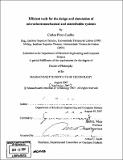| dc.contributor.advisor | Jacob K. White. | en_US |
| dc.contributor.author | Pinto Coelho, Carlos (Carlos Freire da Silva) | en_US |
| dc.contributor.other | Massachusetts Institute of Technology. Dept. of Electrical Engineering and Computer Science. | en_US |
| dc.date.accessioned | 2009-01-23T14:57:23Z | |
| dc.date.available | 2009-01-23T14:57:23Z | |
| dc.date.copyright | 2007 | en_US |
| dc.date.issued | 2007 | en_US |
| dc.identifier.uri | http://dspace.mit.edu/handle/1721.1/42234 | en_US |
| dc.identifier.uri | http://hdl.handle.net/1721.1/42234 | |
| dc.description | Thesis (Ph. D.)--Massachusetts Institute of Technology, Dept. of Electrical Engineering and Computer Science, 2007. | en_US |
| dc.description | Includes bibliographical references (p. 131-136). | en_US |
| dc.description.abstract | In air-packaged surface micromachined devices and microfluidic devices the surface to volume ratio is such that drag forces play a very important role in device behavior and performance. Especially for surface micromachined devices, the amount of drag is greatly influenced by the presence of the nearby substrate. In this thesis a precorrected FFT accelerated boundary element method specialized for calculating the drag force on structures above a substrate is presented. The method uses the Green's function for Stokes flow bounded by an infinite plane to implicitly represent the device substrate, requiring a number of modifications to the precorrected FFT algorithm. To calculate the velocity due to force distribution on a panel near a substrate an analytical panel integration algorithm was also developed. Computational results demonstrate that the use of the implicit representation of the substrate reduces computation time and memory while increasing the solution accuracy. The results also demonstrate that surprisingly, and unfortunately, even though representing the substrate implicitly has many benefits it does not completely decouple discretization fineness from distance to the substrate. To simulate the time dependent behavior of micromechanical and microfluidic systems, a stable velocity implicit time stepping scheme coupling the precorrected FFT solver with rigid body dynamics was introduced and demonstrated. The ODE library was integrated with the solver to enable the simulation of systems with collisions, contacts and friction. Several techniques for speeding up the calculation of each time step were presented and tested. The time integration algorithm was successfully used to simulate the behavior of several real-world microfluidic devices. | en_US |
| dc.description.statementofresponsibility | by Carlos Pinto Coelho. | en_US |
| dc.format.extent | 136 p. | en_US |
| dc.language.iso | eng | en_US |
| dc.publisher | Massachusetts Institute of Technology | en_US |
| dc.rights | M.I.T. theses are protected by
copyright. They may be viewed from this source for any purpose, but
reproduction or distribution in any format is prohibited without written
permission. See provided URL for inquiries about permission. | en_US |
| dc.rights.uri | http://dspace.mit.edu/handle/1721.1/42234 | en_US |
| dc.rights.uri | http://dspace.mit.edu/handle/1721.1/7582 | en_US |
| dc.subject | Electrical Engineering and Computer Science. | en_US |
| dc.title | Efficient tools for the design and simulation of microelectromechanical and microfluidic systems | en_US |
| dc.type | Thesis | en_US |
| dc.description.degree | Ph.D. | en_US |
| dc.contributor.department | Massachusetts Institute of Technology. Department of Electrical Engineering and Computer Science | |
| dc.identifier.oclc | 231621674 | en_US |
